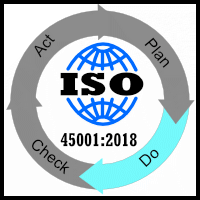|
|
ISO 45001-2018 8.2 Emergency preparednessSend comments on this topic |
FREE QHSE Software Click <HERE> to Learn More |
||
QHSE Support >(Site Map) Health & Safety Guidance > ISO 45001:2018 Clauses > ISO 45001:2018 clause 8 >
ISO 45001:2018 Clause 8.2 Emergency preparedness and response
|
PLAN |
DO |
CHECK |
ACT |
Clause 8.1 Breakdown
8.2 Emergency preparedness and response
Clause 8.2 is one of the clauses that any health and safety professional worth their salt will be comfortable applying the requirements...
The clause opens with "The organization shall establish, implement and maintain a process(es) needed to prepare for and respond to potential emergency situations, as identified in 6.1.2.1, including:"
Clause 6.1.2.1 is one of those clauses that doesn't exist in the standards index. However, being decreed by the 'shall' verbal form, it's a requirement and therefore is an area auditors have to satisfy is being met.
Clause 8.2 Emergency preparedness and response list several steps an organization shall establish in the management of its emergency response and readiness, which include:
•establish plans for circumstances requiring an emergency response, including the provision of emergency first aid and emergency services;
•in establishing emergency plans, take into account the pertinency of interested parties, their capabilities to be able to assist and comply with emergency instructions;
•ensure all workers are aware of the steps required of them in emergency situations;
•ensure communications to contractors, visitors, emergency response services, government authorities and, as appropriate, the local community and others that do not as a rule frequent the workplace / work-site;
•provide training to workers to a level dependant on their emergency situation responsibilities, i.e. fire wardens, first aiders;
•periodically test established emergency plans;
•review the performance results of emergency plan simulated tests, where necessary revise plans and communicate to all relevant parties;
•review unplanned, unscheduled, real-time emergency response performance and if necessary revise plans and communicate to all relevant parties;
•maintain documented information regarding all aspects of emergency planning, training, testing, performance and reviews.
When drawing up emergency plans there are several key elements to consider, a few but not all are listed below:
•a nominated competent worker to take ultimate control;
•a nominated competent worker to liaise with emergency response services (may well be the worker with ultimate control, however, workloads need to be taken into account);
•worker numbers;
•non-worker numbers;
•shift patterns and changes in worker and non-worker numbers;
•site location and site layout;
•effect on neighbourhood and community;
•effect on the environment (nearby rivers, streams, woodlands, where drainage systems outflow to etc);
•existing emergency response equipment (sprinklers, external water hose supplies, first responder kits, emergency lighting);
•position and quantity of hazardous materials;
•emergency plant shut-down and isolation valves plans and or diagrams, where appropriate;
•electrical isolators plans and or diagrams, where appropriate;
•position and distance to the safe refuge point (especially for work-sites with explosive or hazardous material which can become airborne);
•lighting conditions at the safe refuge point (emergencies can occur 24/7)
•management of workers at the safe refuge point;
•alternative safe refuge point;
•how will emergency services access the site (it's not uncommon for evacuated workers to be milling around in the car park when the emergency services arrive at speed, potentially causing a dangerous situation for both parties...);
•vulnerable groups (young, pregnant, blind, deaf, disabled etc.);
•training and competence of the organizations emergency response workers;
•distance to and time to respond for emergency services (ambulance, fire, police etc);
•compliance of workers to follow emergency plan instructions (not continue working until emergency response staff force them to evacuate);
•results of previous emergency drills and evacuations;
•how evacuations are affected by the loss of power;
•alternative exit routes;
•number of emergency exit points;
•guidance sought and offered by emergency services.
A.8.2 Emergency preparedness and response gives a little more help, even if it is somewhat brief: "Emergency preparedness plans can include natural, technical and man-made events that occur inside and outside normal working hours."
Organizations looking for more help in meeting the requirements of clause 8.2 Emergency preparedness and response should look to ISO 45002 0 2018 for a more comprehensive explanation of the types of areas that need addressing is covered.
Useful integrated management system cross references
ISO 9001
•ISO 9001-2015 8.2 Products and Services
ISO 14001
•ISO 14001-2015 8.2 Emergency preparedness
Help file v2.276.407 : QHSE Support - Website On Safe Lines
onsafelines.com QHSE Software 2025 : Webmaster: Brian G. Welch MSc(QHSE), NVQ4(OH&S), CMIOSH




